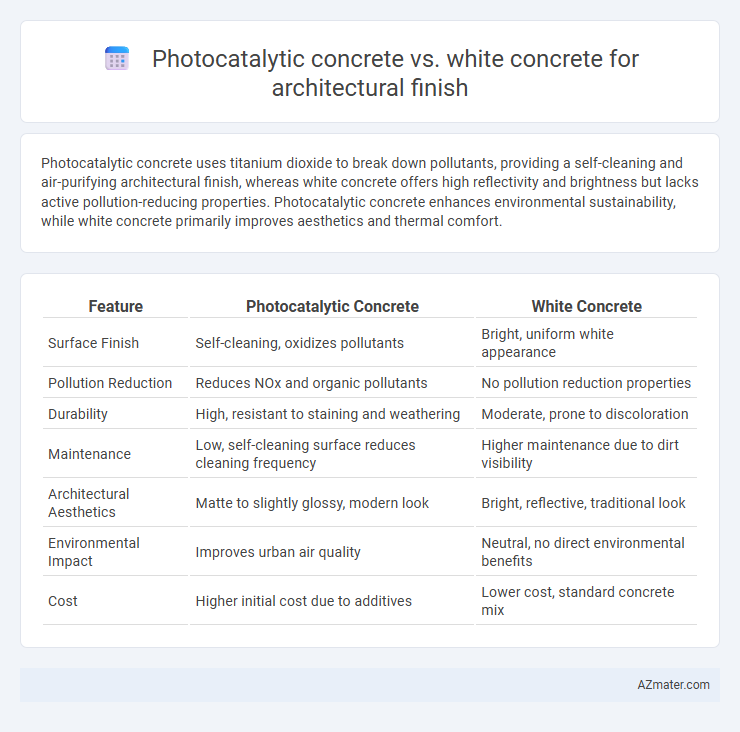Photocatalytic concrete uses titanium dioxide to break down pollutants, providing a self-cleaning and air-purifying architectural finish, whereas white concrete offers high reflectivity and brightness but lacks active pollution-reducing properties. Photocatalytic concrete enhances environmental sustainability, while white concrete primarily improves aesthetics and thermal comfort.
Table of Comparison
| Feature | Photocatalytic Concrete | White Concrete |
|---|---|---|
| Surface Finish | Self-cleaning, oxidizes pollutants | Bright, uniform white appearance |
| Pollution Reduction | Reduces NOx and organic pollutants | No pollution reduction properties |
| Durability | High, resistant to staining and weathering | Moderate, prone to discoloration |
| Maintenance | Low, self-cleaning surface reduces cleaning frequency | Higher maintenance due to dirt visibility |
| Architectural Aesthetics | Matte to slightly glossy, modern look | Bright, reflective, traditional look |
| Environmental Impact | Improves urban air quality | Neutral, no direct environmental benefits |
| Cost | Higher initial cost due to additives | Lower cost, standard concrete mix |
Introduction to Photocatalytic and White Concrete
Photocatalytic concrete incorporates titanium dioxide nanoparticles that activate under UV light to break down pollutants, enhancing air quality and maintaining surface cleanliness. White concrete relies on light-colored aggregates and cement to achieve a bright, reflective finish that reduces heat absorption and provides aesthetic appeal. Both offer durable architectural finishes, but photocatalytic concrete uniquely contributes to environmental sustainability through self-cleaning and pollution-reducing properties.
Chemical Composition and Mechanisms
Photocatalytic concrete incorporates titanium dioxide (TiO2) nanoparticles, which activate under UV light to catalyze the decomposition of pollutants through redox reactions, enhancing air purification. In contrast, white concrete primarily relies on high-reflectance materials like white cement or limestone, reflecting solar radiation to reduce heat absorption without chemical pollutant degradation. The photocatalytic mechanism involves semiconductor electron-hole pair generation that oxidizes organic compounds, whereas white concrete's chemical composition focuses on lighter pigments for brightness and thermal regulation without catalytic activity.
Visual and Aesthetic Differences
Photocatalytic concrete exhibits a dynamic surface that actively breaks down pollutants, maintaining a cleaner and brighter appearance over time compared to white concrete, which can easily show dirt and discoloration. The self-cleaning properties of photocatalytic concrete reduce staining, preserving its original hue and enhancing long-term visual appeal in architectural finishes. White concrete provides a uniform, matte finish but lacks the proactive maintenance of brightness offered by photocatalytic variants, making photocatalytic concrete a superior choice for sustainable and visually striking exterior applications.
Self-Cleaning Properties Comparison
Photocatalytic concrete incorporates titanium dioxide (TiO2) nanoparticles that actively break down organic pollutants and prevent dirt accumulation through photocatalytic reactions, enhancing self-cleaning capabilities compared to conventional white concrete. White concrete primarily relies on its light surface to mask stains but lacks the chemical activity to degrade contaminants, resulting in more frequent cleaning requirements. Studies indicate photocatalytic concrete reduces surface dirt and grime by up to 40% more than white concrete, making it superior for maintaining architectural finishes with minimal maintenance.
Impact on Urban Air Quality
Photocatalytic concrete significantly improves urban air quality by actively breaking down pollutants such as nitrogen oxides (NOx) through a photocatalyst like titanium dioxide embedded in its surface. White concrete reflects more sunlight, reducing urban heat island effects but does not chemically reduce air pollutants. Implementing photocatalytic concrete in urban architecture offers a dual benefit of aesthetic appeal and effective air pollution mitigation.
Durability and Maintenance Requirements
Photocatalytic concrete enhances durability by actively breaking down pollutants and organic matter on its surface, reducing dirt accumulation and minimizing maintenance needs compared to traditional white concrete. It resists discoloration and staining over time, ensuring a cleaner and more sustainable architectural finish. White concrete, while visually bright, often requires more frequent cleaning and protective treatments to maintain its appearance in polluted or weather-exposed environments.
Cost Implications and Life Cycle Analysis
Photocatalytic concrete incorporates titanium dioxide to actively reduce pollutants, increasing initial material costs compared to traditional white concrete but offering long-term savings through decreased maintenance and environmental remediation expenses. Life cycle analysis reveals photocatalytic concrete's ability to improve air quality and reduce urban heat island effects, potentially extending service life and reducing repainting frequency, whereas white concrete primarily relies on reflective properties without active pollutant degradation. Cost implications favor photocatalytic concrete in high-pollution or urban areas due to enhanced durability and environmental benefits, while white concrete remains a cost-effective option where initial budget constraints predominate.
Environmental Sustainability Considerations
Photocatalytic concrete contains titanium dioxide, enabling it to break down pollutants and reduce urban air pollution, enhancing environmental sustainability by improving air quality. White concrete reflects more sunlight due to its higher albedo, which helps mitigate the urban heat island effect and decreases energy consumption in surrounding buildings. Both materials offer distinct eco-friendly benefits: photocatalytic concrete actively purifies air, while white concrete provides thermal regulation, supporting sustainable architectural finishes.
Applications in Modern Architectural Design
Photocatalytic concrete enhances air purification and self-cleaning properties, making it ideal for urban facades and public spaces where pollution reduction is critical. White concrete offers superior thermal reflectivity and aesthetic brightness, commonly used in contemporary designs emphasizing energy efficiency and minimalism. Both materials address sustainability goals but cater to different architectural needs, with photocatalytic concrete promoting environmental health and white concrete enhancing visual comfort and cooling.
Choosing the Right Concrete for Your Project
Photocatalytic concrete offers self-cleaning properties by breaking down pollutants and organic matter, making it ideal for urban architectural finishes that prioritize sustainability and reduced maintenance. White concrete provides a bright, reflective surface enhancing natural light and aesthetic appeal in architectural designs, often chosen for visually striking projects. Selecting between photocatalytic and white concrete depends on project goals such as environmental impact, durability, and desired visual effect.

Infographic: Photocatalytic concrete vs White concrete for Architectural finish
 azmater.com
azmater.com